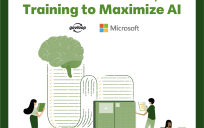Technology originally developed to improve PC-based gaming and multimedia applications nearly 30 years ago is now driving advances in the field of artificial intelligence (AI).
In the early 1990s, when PC gaming was beginning to take off, the Graphics Processing Unit (GPU) was invented by NVIDIA to render an image by breaking it up into multiple tasks that could be executed in parallel.
Today, the same approach accelerates processing for a wide range of applications, not just on PCs but also on the world’s fastest computers.
NVIDIA is working with the federal government to incorporate AI to enhance decision-making and operations across key mission areas. The focus is on AI to improve situational awareness and decision-making, to enhance maintenance and supply operations, and to augment the capabilities of personnel with new ways of working that offload tedious cognitive and physical tasks.
With the advent of AI, the GPU is more important than ever, said Curt Smith, Vice President, GPU Data Center Architect, for NVIDIA, a pioneer of graphics processing technology.
Accelerated Learning
To learn how to interpret data and automate tasks – for example, to recognize objects or understand human speech – AI needs to ingest and analyze large amounts of data. As the AI market booms, the programs are growing more complex and the demand for compute power is accelerating.
When it comes to AI training and inference, GPUs can accelerate performance 10x over CPUs, said Smith – which means that the time it takes to train an AI model can go from days to hours or even minutes.
“The compute processing needed with AI is doubling every few months,” he said. “GPUs are the key to staying at state of the art.”
But NVIDIA believes that AI doesn’t just require more compute power – it requires a different way of thinking about the data center.
The Data Processing Unit
Traditionally, government data centers are focused on general processing and running mission systems. As AI becomes more advanced and more important to the nation, government organizations need to look at reorganizing their infrastructure, Smith said.
In addition to the CPU and GPU, agencies also need to think about the DPU – that is, the data processing unit, which encompasses compute, networking, storage and other core data center functions. The DPU is “a single compute entity that’s programmable, AI-enabled and can deliver greater levels of security, performance and efficiency,” Smith said.
This advanced infrastructure also enables the rapid deployment of AI-enabled services through the cloud and data centers, he said. “You can work with larger and larger and larger datasets, and more and more complex models, to build better realtime AI services. Today, GPU-accelerated systems assist during natural disasters; serve communities by improving safety; power efficiency and traffic flows; and help leaders solve previously unsolvable problems in cyberdefense and cyber resilience. These revolutionary solutions are made possible with NVIDIA technology.”
That’s NVIDIA’s vision for the government data center, said Smith. “Our hope is to deliver solutions that they never thought possible – and to enable customers to make data-driven high-quality decisions faster than ever before.”
This article is an excerpt from GovLoop’s recent guide, “The State of AI in Government: Policies, Challenges & Practical Use Cases.” Download the full guide here.





Wow! I had no idea NVIDIA had a hand in PC Gaming that far back.